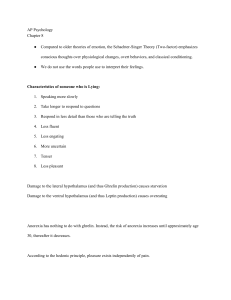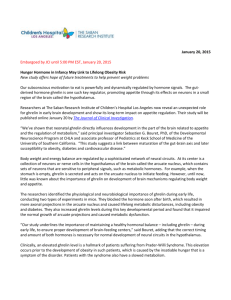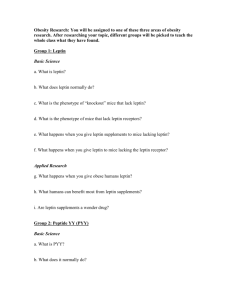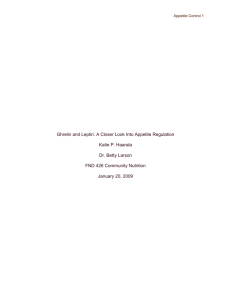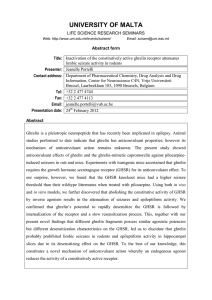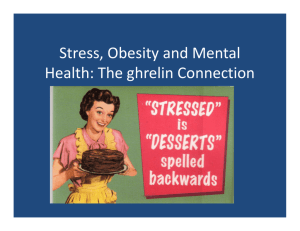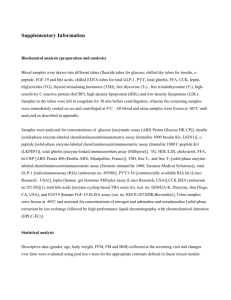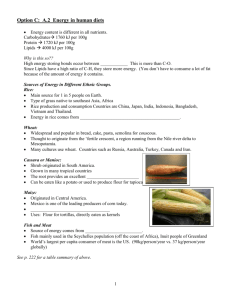English Article Outline
advertisement
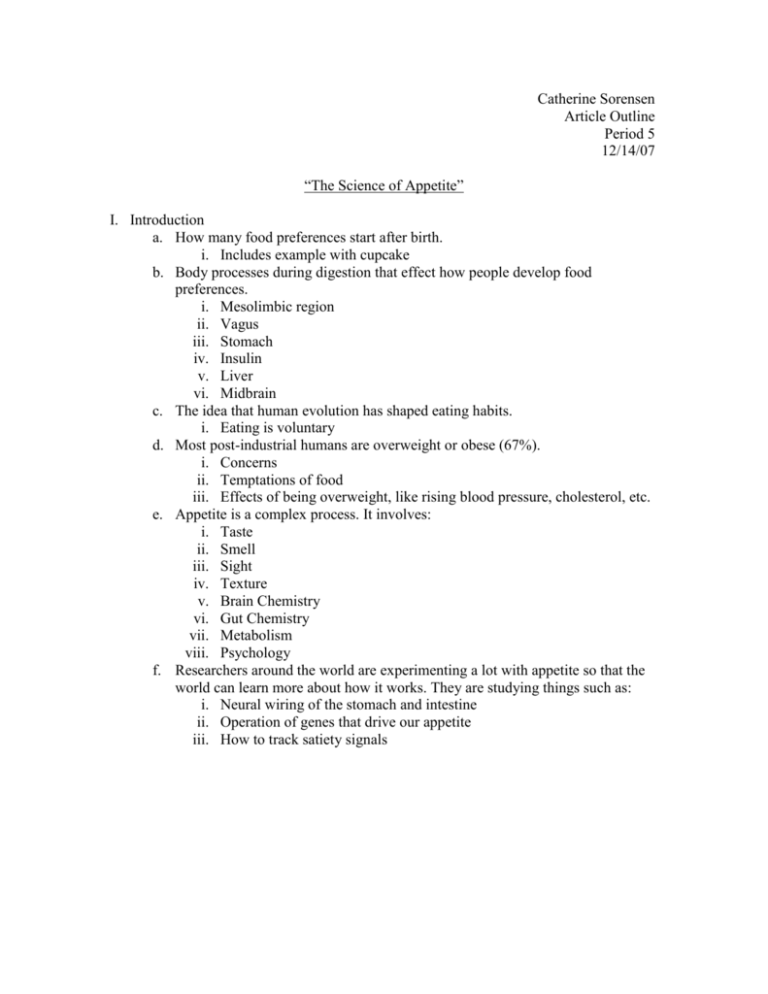
Catherine Sorensen Article Outline Period 5 12/14/07 “The Science of Appetite” I. Introduction a. How many food preferences start after birth. i. Includes example with cupcake b. Body processes during digestion that effect how people develop food preferences. i. Mesolimbic region ii. Vagus iii. Stomach iv. Insulin v. Liver vi. Midbrain c. The idea that human evolution has shaped eating habits. i. Eating is voluntary d. Most post-industrial humans are overweight or obese (67%). i. Concerns ii. Temptations of food iii. Effects of being overweight, like rising blood pressure, cholesterol, etc. e. Appetite is a complex process. It involves: i. Taste ii. Smell iii. Sight iv. Texture v. Brain Chemistry vi. Gut Chemistry vii. Metabolism viii. Psychology f. Researchers around the world are experimenting a lot with appetite so that the world can learn more about how it works. They are studying things such as: i. Neural wiring of the stomach and intestine ii. Operation of genes that drive our appetite iii. How to track satiety signals II. Primordial Gluttony a. Overeating can be traced back to ancestors. i. It was necessary for surviving when food was scarce ii. It was seen as sensible and necessary b. Humans are evolutionarily made to eat a lot of fatty foods, because for our ancestors, fatty foods were the most nutritional. i. We are programmed to not immediately feel when were full. c. Nevertheless, bodies work to keep themselves balances (they want to be healthy) i. The average adult male will consume 900,000 calories and not rise or fall by more than a pound. ii. 4,000 calories is equal to one pound d. The importance of time schedules when eating. i. Humans tend to get hungry at the times they are used to being fed. III. The Hunger Hormone a. Ghrelin i. It is the hunger hormone ii. It is produced in the gut in response to meal schedules iii. Sight or taste of food alone can make people hungry iv. Ghrelin reaches three areas in the brain: hindbrain, hypothalamus, and mesolimbic reward center. b. Ghrelin levels i. When mealtimes approach ghrelin levels are produced at higher amounts (by a lot) ii. Effects of adding or loosing a meal (ghrelin levels change too) iii. Example: ghrelin in animals, gastric bypass surgery, anorexics c. The stomach and the upper intestine work to slow things down in the hunger process, they let our brain know when we are full. Message is reinforced by three substances: i. Cholecystokinin d. The other two hormones: i. GLP -1 ii. PYY iii. They are produced in lower gut iv. They tell your stomach to stop what it is doing until there is more room in the intestine for more food to be digested. v. Other effects vi. They regulate overall energy balance too e. Leptin i. An appetite suppressing hormone ii. Produced in body fat iii. Fatter people produce more leptin iv. Its effects on community f. Leptin has not succeeded as many people hoped. i. At some point is stops working ii. Many obese people have grown resistant to it IV. Rejiggering the System a. There are many other hormones involved in the appetite-control system. b. Advanced work on the human metabolic engine may be more provide more insight on our body’s metabolic processes. c. Carrie Haskell-Luevano is researching receptor sights on individual neurons to which appetite-control chemicals bond. i. It is very complex ii. Melanocortin-4 d. MC-4 is gateway to many chemicals in body. i. If MC-4 is blocked hormones, like leptin, don’t work e. MC-3 receptor i. Not as powerful as MC-4 ii. Helps brain govern energy balance iii. MC-3 and MC-4 mutations would not explain all cases of obesity f. 2 Researchers and their findings. i. Flier and a protein that responds to leptin ii. Evans and PPAR’s iii. The more active a system is the more fat gets burned, and whatever is not used gets stored. g. Researchers are trying to find ways to boost metabolism, which can lead to more efficient burning. h. Michael Cowley and his research on the similarity between eating habits and drug addiction. i. Few people have power to keep amounts reasonable i. Ghrelin and the mesolimbic region (it is more powerful in this region of the brain) i. Relating levels of activity in brain in obese people and how they are similar to drug addicts brain levels of activity V. What can you do? a. Drugs don’t help, but ongoing research may bring up results soon. i. In Baton Rouge there is a very sophisticated test kitchen for metabolism. ii. Trying to discover what meals satisfy humans the best with the least fat. b. Research in the Baton Rouge Kitchen i. Trying to find more precise way to balance glucose loads many foods deliver to the body. ii. Glucose effects c. Another approach to appetite control d. e. f. g. i. Morrison found that CCK followed by leptin worked better in curbing appetite than either one alone People on diets may notice their hunger pains going down as time goes by i. Leptin may be involved in this Another way to attack hunger more aggressively i. Barbara Rolls advocates eating in moderation ii. Eat foods high in volume and low in calories in order to stimulate the digestive systems distension nerves. Importance of eating a variety of tastes and textures Even though evolution has made it so human’s want to eat everything they can, they should avoid doing so. Health is at stake.
